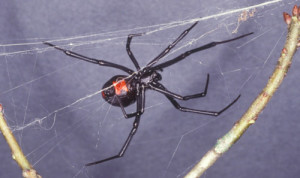 Southern Black Widow
Southern Black Widow
The Southern black widow spider, Latrodectus mactans (Fabricius), is a venomous spider found throughout the southeastern United States. Widow spiders received their name from the belief that they would kill and consume their mate following copulation. However, the practice was mainly observed in laboratory settings under crowded conditions. It is believed that sexual cannibalism within the widow species in natural settings is more associated with the male’s physical inability to escape rather than the female’s interest in consuming him (Breene and Sweet 1985).
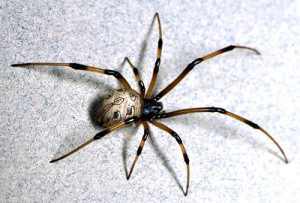
Brown Widow Spider
The brown widow is suspected to have evolved in Africa although it was first described from South America, which adds confusion as to where it might have originated. The Brown Widow Spider is a cosmopolitan tropical and subtropical spider having established populations in Hawaii, Florida, some Caribbean Islands, parts of Australia, South Africa, Japan, and Cyprus. In North America, the Brown Widow Spider was restricted for many decades to the Florida peninsula. However, around the year 2000, it started showing up in other Gulf Coast states. Brown widows are now known from Texas to Georgia and South Carolina.
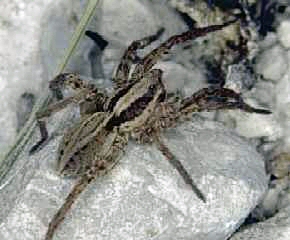
Wolf Spider
Wolf spiders range from about 1/2 inch to 2 inches in length, hairy, and are typically brown to gray in color with various markings or lines. Wolf spider mothers carry their large egg sacs around with them. When the young spiderlings hatch they climb onto their mother’s back and ride around until partially grown. Wolf spiders are not poisonous, though as with all spiders, bites may cause reactions in certain individuals.
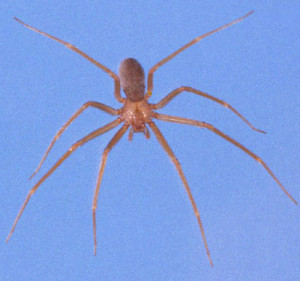 Brown Recluse Spider
Brown Recluse Spider
The brown recluse spider, Loxosceles reclusa Gertsch & Mulaik, is frequently reported in Florida as a cause of necrotic lesions in humans. For example, in the year 2000 alone, Loft (2001) reported that the Florida Poison Control Network had recorded nearly 300 alleged cases of brown recluse bites in the state; a subset of 95 of these bites was reported in the 21 counties (essentially Central Florida) under the jurisdiction of the regional poison control center in Tampa.
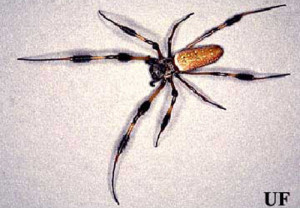 Golden Silk Spider
Golden Silk Spider
In Florida and other southeastern states, the golden silk spider, Nephila clavipes (Linnaeus), a large orange and brown spider with the feathery tufts on its legs is well know to most native southerners. It is particularly despised by hikers and hunters, as during late summer and fall the large golden webs of this species make a sticky trap for the unwary. However, as is typical with most spiders, there is little real danger from an encounter with the golden silk spider. The spider will bite only if held or pinched, and the bite itself will produce only localized pain with a slight redness, which quickly goes away. On the whole, the bite is much less severe than a bee string. Typically, the webs are made in open woods or edges of dense forest, usually attached to trees and low shrubs, although they may be in the tops of trees or between the wires of utility lines (Krakauer 1972). Prey consists of a wide variety of small to medium-sized flying insects, including flies, bees, wasps, and small moths and butterflies (Robinson and Mirick 1971). We have also seen them feeding on small beetles and dragonflies. These spiders are not usually found in row crops, due to requirements of web support, but they were one of the two most common orb-weavers in citrus groves (Muma 1975) and have been recorded from pecan (Whitcomb unpublished). Small, immature instars occasionally make webs between rows in soybean fields (Whitcomb and Edwards unpublished).
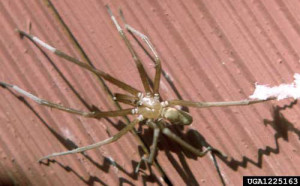 Southern House Spider
Southern House Spider
The southern house spider (Figures 1 to 4), Kukulcania hibernalis (Hentz 1842), is a conspicuous arachnid in Florida due to its relatively large size and distinctive flat, tangled web. It is common throughout Florida and much of the southern United States in human populated areas. As a group, filistatid spiders are known as crevice spiders, and this species is sometimes referred to as the southern crevice spider.
Males of this species are often mistaken for the notorious brown recluse spider, Loxosceles reclusa Gertsch and Mulaik, because of their color and general shape. Southern house spiders are not known to have a dangerous bite. However, two bite cases reportedly caused the victims pain and swelling for up to two days.
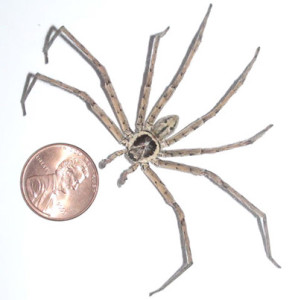 Huntsman Spider
Huntsman Spider
The huntsman spider, Heteropoda venatoria (L.), sometimes called the giant crab spider or the banana spider (due to its occasional appearance in marketed bananas), is a cosmotropical species introduced into and now occurring in the U.S., in subtropical areas of Florida, Texas, and California. It is presumed to have been introduced from Asia, where many of its closest relatives live (Gertsch 1948). It is sometimes mistaken for a large brown recluse, Loxosceles reclusa Gertsch and Mulaik, a poisonous spider in the family Loxoscelidae, but it is neither related nor is it dangerous. Some authors place this spider in the family Heteropodidae, due to the uncertainty of the name Sparassidae (Platnick and Levi 1973).
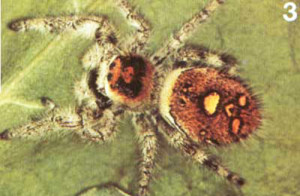 Regal Jumping Spider
Regal Jumping Spider
Except for two pantropical species (Edwards 1979), the jumping spider most frequently encountered in Florida is Phidippus regius C.L. Koch. This species is aptly named in terms of its size, as it is the largest jumping spider in eastern North America. The species is found in the southeastern U.S., the Greater Antilles, and the Bahamas, but is most common in peninsular Florida.
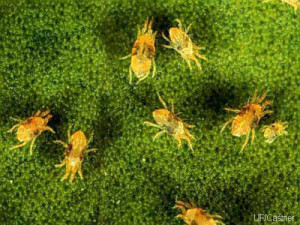 Twospotted Spider Mite
Twospotted Spider Mite
The twospotted spider mite is oval in shape, about 1/50 inch long and may be brown or orange-red, but a green, greenish-yellow or an almost translucent color is the most common. The female is about 0.4 mm in length with an elliptical body that bears 12 pairs of dorsal setae. Overwintering females are orange to orange-red. The body contents (large dark spots) are often visible through the transparent body wall. Since the spots are accumulation of body wastes, newly molted mites may lack the spots. The male is elliptical with the caudal end tapering and smaller than the female. The axis of knob of aedeagus is parallel or forming a small angle with axis of shaft.
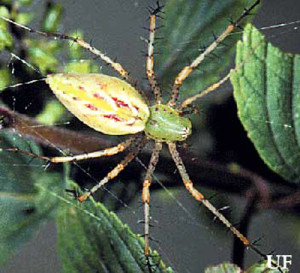 Green Lynx Spider
Green Lynx Spider
In Florida, the green lynx spider, Peucetia viridans (Hentz), is the spider most often received for identification by Division of Plant Industry entomologists. It is a conspicuous, large, bright green spider found on many kinds of shrublike plants throughout the southern United States and is the largest North American lynx spider. Although it is common throughout Florida and aggressively attacks its insect prey, it very seldom bites humans. While its bite is of little concern to humans, the green lynx spider is of interest because of its potential use in agricultural pest management.
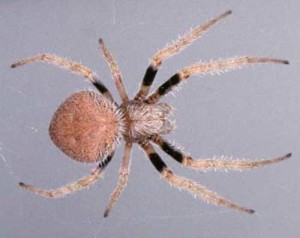 Tropical Orb Weaver Spider
Tropical Orb Weaver Spider
Among the several large orb weavers occurring in Florida is Eriophora ravilla (C. L. Koch 1844). Unlike similar large spiders of the genus Neoscona (Edwards 1984), Eriophora ravilla is not a conspicuous member of the diurnal fauna during its adult stage. Nevertheless, nursery inspectors regularly encounter specimens of this species and submit them to the Division of Plant Industry for identification. Bites of this species are not known to cause serious effects to humans.
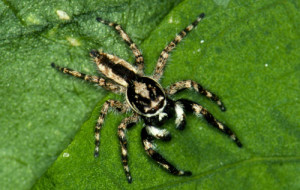 Jumping Spider
Jumping Spider
Jumping spiders, or salticids, are so named because they have a highly coordinated jumping ability with which they capture prey and traverse from plant to plant. Their sense of sight is extraordinary for invertebrates; they can see in color (DeVoe 1975), and the large front eyes focus on objects (Land 1972). Many are marked with contrasting colors or bands, especially the males who display this ornamentation while dancing before females to win acceptance for mating. Jumping spiders as adults may be as small as 1 mm in length or as large as 23 mm, but most are 5 to 10 mm. All jumping spiders are harmless to humans, although the larger species can give a locally painful bite if roughly handled.
Two species of jumping spiders occurring in Florida, the gray wall jumper, Menemerus bivittatus (Dufour), and the pantropical jumper, Plexippus paykulli (Audouin), have been imported by man from the tropical Old World. Both are almost exclusively associated with man-made structures, usually buildings where they may be numerous around lights at night, catching the insects attracted to the lights. Both are medium-large jumping spiders, about 8 to 12 mm in length. Adults and immatures of both species are present all year, although most mating and reproduction begin in the fall and continue until spring. Both are found from Florida to Texas and south to Paraguay. Menemerus bivittatus also occurs in California, and both species are widely distributed in the Old World tropics. The occurrence of dense populations of these two species around human habitations makes them of considerable beneficial importance in the control of flies, mosquitoes, and other human pests. At the same time, since they do not build webs to capture prey, they do not create the cobwebs which so often annoy many people.
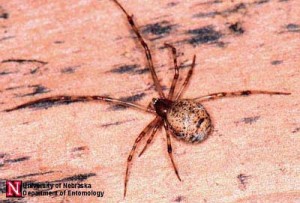 Common House Spider
Common House Spider
The common house spider, Achaearanea tepidariorum (C.L. Koch), may be the most abundant of the several species of spiders that live in the company of man in the southeastern United States. Although Archer (1947) thought that Achaearanea tepidariorum was less common inside houses than Pholcus phalangioides Fuesslin (Pholcidae) in Alabama, he also noted its abundance.
Levi (1967) considered A. tepidariorum to be a cosmopolitan species. Although the species was first described from Germany, it appears to be native to South America, judging from the numerous similar relatives which occur there. It is abundant in Central America and Mexico, and occurs as far north as southern Canada (Levi 1955). It has been recorded from most of the contiguous United States (Levi and Randolph 1975). The species probably now has a worldwide distribution, having been carried around the world by man on plants. Although A. tepidariorum belongs to the same family (Theridiidae) as the notorious black widow spiders (Latrodectus spp.), it is not known to be dangerous to humans. One case of serious allergic reaction to the bite of A. tepidariorum is known from Gainesville, Florida.
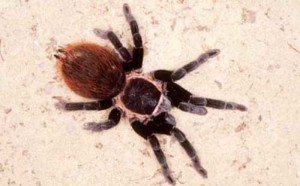 Mexican Redrump Tarantula
Mexican Redrump Tarantula
In early August 1996, a large black spider with red hairs on its abdomen was collected by citrus grove workers in St. Lucie County, Florida, west of Ft. Pierce. The workers gave the spider to a citrus survey crew, who brought it back to Gainesville. The first author examined the specimen (which was only half grown) and tentatively identified it as Brachypelma vagans (Ausserer), a species known to be commonly imported by the pet trade under assorted common names (Central American, Guatemalan, Honduran, or Mexican black velvet tarantulas). The accepted common name is Mexican redrump tarantula (Breene 1995).
About a week later, a female and several young spiders were unearthed by grove workers in the same area. Subsequently, several survey expeditions led by the second author captured or destroyed about 100 specimens of all ages from small spiderlings to adult females and males. One of these males was sent to Rick C. West, a tarantula expert and research associate of the Royal British Columbia Museum, for identification. Mr. West confirmed that this species was B. vagans (personal communication 1996). He also noted that the species had been commonly imported into Miami since the early 1970s.
